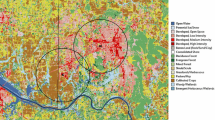Abstract
A total of seventeen vertical profiles of ozone were obtained during an Indo-USSR collaborative experiment on ozonesonde intercomparison conducted at Thumba during March 1983. The vertical distribution of ozone was measured using rocket-borne, balloon-borne as well as ground-based instruments. Four different rocket ozonesondes from India and USSR and the balloon ozonesonde were used to makein situ observations of ozone concentrations in addition to the Dobson spectrophotometric observations of total ozone and Umkehr. The rocket and the balloon launchings were effected in three salvos and measurements were made at different times of the day as well as during night. The results of all these measurements are used to obtain a mean ozone vertical distribution over Thumba foT the spring equinoxial period. The mean profile shows the maximum ozone concentration at 27 km with a value of (3.86±0-52)×1012 molecules per cc. Comparison of this mean profile with available satellite data for the equatorial regions shows that, in general, the Thumba values are lower by 10–15% at altitudes below 40 km and larger at altitudes above 50 km compared to the satellite results. The data also show evidence for a day-to-day variability and a possible day-to-night variability in the ozone vertical distribution with the night-time values higher than the daytime values at all altitudes above 35 km and the difference is found to increase with the increasing altitude.
Similar content being viewed by others
References
Acharya Y Bet al 1984 The ozonesonde intercomparison experiment at Thumba;Adv. Space Res. 4 59–68
Aikin A C, Woodgate R and Smith H J P 1984 Equatorial ozone profiles from the solar maximum mission—A comparison with theory;Planet. Space Sci. 32 503–513
Bass A M and Paur R J 1985 The ultraviolet cross sections of ozone: I The measurements; inAtmospheric ozone (eds) by C S Zerefos and A Ghazi, (Dordrecht: D Reidel) pp. 606–610
Brezgin N I 1982 Technique of measuring the vertical ozone distribution by optical methods using meteorological rockets;Meteorol. Hydrol. (Moscow) 4 100–105
Dutch H W 1980 Vertical ozone distribution and tropospheric ozone;Proc. NATO Advance Study Institute (ed) A C Aikin pp. 7–30 (Washington: US Dept. of Transportation)
Frederick J E, Guenther B W, Hays P B and Heath D F 1978 Ozone profiles and chemical loss rates in the tropical stratosphere deduced from back-scatter ultraviolet measurements;J. Geophys. Res. 83 953–958
Herman J R 1979 The response of stratospheric constituents to a solar eclipse, sunrise and sunset;J. Geophys. Res. 84 3307–3310
Klenk K F, Monosmith B and Bhartia P K 1985 Absorption coefficients of ozone for the back-scattered UV instruments-SBUV, TOMS and BUV and for the Dobson instrument;Atmospheric ozone (eds) C S Zerefos and A Ghazi (Dordrecht: D Reidel) pp 625–629
Ko M K W, McElroy M B, Weisenstein D K and Sze N D 1986 Lightning: a possible source of stratospheric odd nitrogen;J. Geophys. Res. 91 5395–5404
Komhyr W D and Evans R D 1980 Dobson spectrophotometer total ozone measurement errors caused by interfering absorbing species such as SO2, NO2 and photochemically produced O3 in polluted air;Geophys. Res. Lett. 7 157–160
Kononkov V A, Kononkov V I and Perov S P 1982 Experiment employing chemiluminescent method for measurement of atmospheric ozone onboard M-100B meteorological rockets;Proc. symposium on investigations of atmospheric ozone, TBILIS, p 78–82
Krueger A J and Minzner R A 1976 A mid-latitude ozone model for the 1976 US Standard Atmosphere;J. Geophys. Res. 81 4477–481
Kundu N 1982 Reference ozonosphere over India; ISRO-IMAP-SR-09-82 ISRO Bangalore India
Lal S and Subbaraya B H 1983 Solar eclipse induced variations in mesospheric ozone concentrations;Adv. Space Res. 2 205–208
Lovill J E and Ellis J S 1983 Correlative studies of satellite ozone sensor measurements;Geophys. Res. Lett. 10 447–150
McPeters R D, Heath D F and Bhartia P K 1984 Average ozone profiles for 1979 from the NIMBUS 7 SBUV instrument;J. Geophys. Res. 89 5199–5214
Somayajulu Y V, Zalpuri K S and Sampath S 1981 Rocket measurement of ozone density distribution in the equatorial stratosphere and mesosphere;Indian J. Radio Space Phys. 10 197–200
Subbaraya B H and Lal S 1981 Rocket measurements of ozone concentrations in the stratosphere and mesosphere over Thumba;Proc. Indian Acad. Sci. (Earth. Planet. Sci.) 90 173–187
Subbaraya B H, Jayaraman A and Shyam Lal 1985 Rocket measurements of the vertical structure of the ozone field in the tropics; inAtmospheric Ozone (eds) C S Zerefos and A Ghazi (Dordrecht: D. Reidel) pp 295–299.
Author information
Authors and Affiliations
Rights and permissions
About this article
Cite this article
Subbaraya, B.H., Appu, K.S., Chatterjee, K.P. et al. Results from the Indo-USSR ozonesonde intercomparison experiment. Proc. Indian Acad. Sci. (Earth Planet Sci.) 96, 25–40 (1987). https://doi.org/10.1007/BF02842635
Received:
Revised:
Issue Date:
DOI: https://doi.org/10.1007/BF02842635



